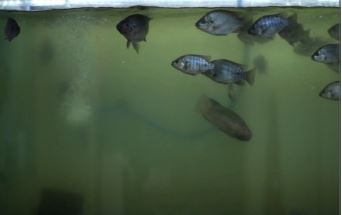Ben Saminiano, Arnel
Fajardo, and Ruji Medina, from the
different institute of the Philippines. wrote a research article about, Nile
Tilapia Count and Location: AI and CLAHE Unleashed. entitled, Count and
location determination of Nile Tilapia (Oreochromis niloticus) using
convolutional neural network and CLAHE. This research paper published by the Journal of Biodiversity and Environmental Sciences (JBES). an open access scholarly
research journal on Biodiversity. under the affiliation of the International
Network For Natural Sciences | INNSpub. an open access
multidisciplinary research journal publisher.
Abstract
Fish counting in
aquaculture is an important task in fish population estimation. However, it is
very challenging because of the diversity of backgrounds, uncertainty of fish
motion, and obstruction between objects. To solve this problem, a model using
Convolutional Neural Network (CNN) and Contrast Limited Adaptive Histogram
Equalization (CLAHE) is proposed to provide an advanced and efficient counting
method for aquaculture. The methodology involved image acquisition, CNN
implementation, and evaluation. First, images were manually annotated from
video frames. Then, a CNN was trained on the training dataset to detect the
tilapia and determine its location. Lastly, the performance of the method was
evaluated and compared with other assessment methods. The results show that the
study gained 95%, 87%, and 91% for precision, recall, and F1-score, respectively.
Further, the mean average precision at 0.5 resulted in 94.21%; thus, the study
can detect and locate the fish in a tank and be integrated into a feeding
management system.
Read more : Andrographis Paniculata: Exploring Medicinal Marvels | InformativeBD
Introduction
Accurate counting of
organisms, such as Nile Tilapia (Oreochronis niloticus), is important for
various applications, including fisheries management, environmental monitoring,
and aquaculture operations (Li et al., 2020). In the Philippines, tilapia is
the second most important cultured species, with approximately 281,111 MT of total
production in 2021. In 2020, tilapia made up 20% of the aquaculture production
in the country, with Central Luzon as the leading producer. Tilapia is an
important commodity for food security and economic development (PCAARRD, n.d.).
The tilapia industry in
the Philippines has made notable growth in production from 2002 to 2022, with
an increase of 115.58%. This may be attributed to several programs done by the
government, such as improving the strain of tilapia and improving the
technology in production and culture to sustain industry growth (Bureau of
Fisheries and Aquatic Resources, 2022).
However, despite the
progress made in tilapia aquaculture, problems and challenges persist.
Pollutionrelated problems like diseases and water quality management, sources
of quality fingerlings, and market competition are among the key challenges
faced by farmers (Bureau of Fisheries and Aquatic Resources, 2022). Addressing
these challenges and enhancing the efficiency and sustainability of tilapia
production is crucial for the industry's continued growth.
In this context,
developing an automated methodology for accurate surface tilapia detection
using a Convolutional Neural Network (CNN) brings an opportunity to improve
tilapia farming practices. Leveraging the capabilities of CNN and Contrast
Limited Adaptive Histogram Equalization (CLAHE) aims to develop an approach to
determine whether Nile Tilapia are at the surface or submerged. The insights
gained from this research can contribute to optimizing feeding strategies, improving
management practices, and enhancing tilapia aquaculture's overall productivity.
The paper is presented
as follows: Section 1 introduces the motivation for the research. Section 2
concentrated on the related works on image processing, CNN, and CLAHE. The
methodology of the research is presented in Section 3. Section 4 presents the
Tests and Results. Finally, Section 5 discussed the conclusion and future
works.
Reference
Bureau of Fisheries and
Aquatic Resources. 2022. The Philippine Tilapia Industry Roadmap (2022-2025).
Conrady CR, Er Ş,
Attwood CG, Roberson LA, de Vos L. 2022. Automated detection and
classification of southern African Roman seabream using mask R-CNN. Ecological
Informatics 69, 101593.
Jose JA, Kumar CS,
Sureshkumar S. 2022. Tuna classification using super learner ensemble of
region-based CNN-grouped 2D-LBP models. Information Processing in
Agriculture 9(1), 68–79.
Li D, Miao Z, Peng F,
Wang L, Hao Y, Wang Z, Chen T, Li H, Zheng Y. 2020. Automatic counting
methods in aquaculture: A review.
Lumauag R, Nava M. 2019.
Fish tracking and counting using image processing. 2018 IEEE 10th International
Conference on Humanoid, Nanotechnology, Information Technology, Communication
and Control, Environment and Management, HNICEM 2018, 1-4. https://doi.org /10.1109/HNICEM.2018.8666369
Mandal R, Connolly RM,
Schlacher TA, Stantic B. 2018. Assessing fish abundance from underwater
video using deep neural networks. In Proceedings of the International Joint
Conference on Neural Networks (Vols. 2018-July). https://doi.org/10.1109
/IJCNN.2018.8489482
Mishra A, Gupta M,
Sharma P. 2018. Enhancement of Underwater Images using Improved CLAHE.
2018 International Conference on Advanced Computation and Telecommunication,
ICACAT 5, 1-6. https://doi.org/10.1109/ICACAT.2018.8933665
Muksit AAl, Hasan F,
Hasan Bhuiyan Emon MF, Haque MR, Anwary AR, Shatabda S. 2022. YOLO-Fish: A
robust fish detection model to detect fish in realistic underwater environment.
Ecological Informatics 72, 101847. https://doi.org/10.1016
/J.ECOINF.2022.101847
PCAARRD. 2023.
(n.d.). Tilapia – Industry Strategic Science and Technology Plans (ISPs)
Platform. Retrieved June 24, 2023, from https://ispweb. pcaarrd.
dost.gov.ph/tilapia-2/
Redmon J, Farhadi A. 2018.
YOLOv3: An incremental improvement. ArXiv.
Saminiano B. 2020.
Feeding Behavior Classification of Nile Tilapia (Oreochromis niloticus) using
Convolutional Neural Network. International Journal of Advanced Trends in
Computer Science and Engineering 9(1.1 S I), 259–263. https://doi.org /10.30534/ijatcse/2020/4691.12020
Wang H, Zhang S, Zhao
S, Wang Q, Li D, Zhao R. 2022. Real-time detection and tracking of fish
abnormal behavior based on improved YOLOV5 and SiamRPN++. Computers and
Electronics in Agriculture 192, 106512. https://doi.org/10.1016 /J.COMPAG.2021.106512
Yu C, Fan X, Hu Z, Xia
X, Zhao Y, Li R, Bai Y. 2020. Segmentation and measurement scheme for fish
morphological features based on Mask R-CNN. Information Processing in
Agriculture 7(4), 523–534. https://doi.org/10.1016/J.INPA.2020.01.002











%20in%20full.JPG)


0 comments:
Post a Comment